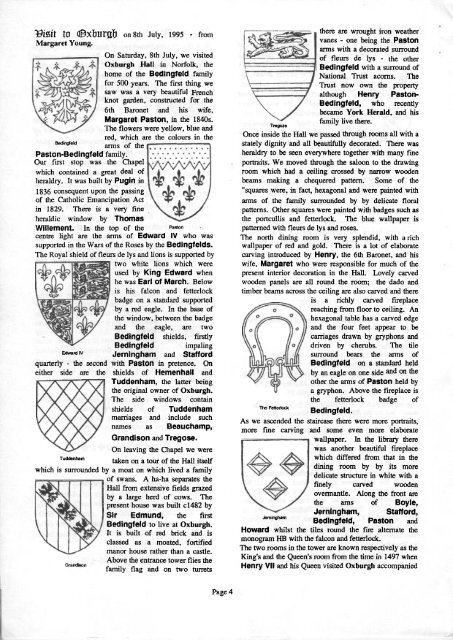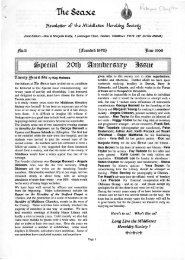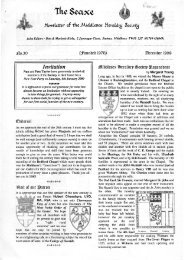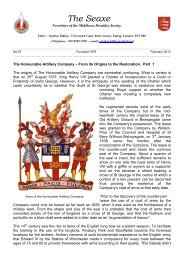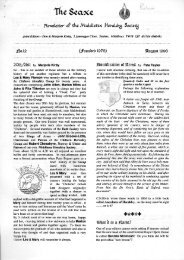The Seaxe - Middlesex Heraldry Society
The Seaxe - Middlesex Heraldry Society
The Seaxe - Middlesex Heraldry Society
You also want an ePaper? Increase the reach of your titles
YUMPU automatically turns print PDFs into web optimized ePapers that Google loves.
Visit to Oxburgh<br />
Margaret Young.<br />
Bedingfeld<br />
on 8th July, 1995 - from<br />
On Saturday, 8th July, we visited<br />
Oxburgh Hall in Norfolk, the<br />
home of the Bedingfeld family<br />
for 500 years. <strong>The</strong> first thing we<br />
saw was a very beautiful French<br />
knot garden, constructed for the<br />
6th Baronet and his wife,<br />
Margaret Paston, in the 1840s.<br />
<strong>The</strong> flowers were yellow, blue and<br />
red, which are the colours in the<br />
arms of the<br />
Paston-Bedingfeld family.<br />
Our first stop was the Chapel<br />
which contained a great deal of<br />
heraldry. It was built by Pugin in<br />
1836 consequent upon the passing<br />
of the Catholic Emancipation Act<br />
in 1829. <strong>The</strong>re is a very fine<br />
heraldic window by Thomas<br />
Willement. In the top of the Paston<br />
centre light are the arms of Edward IV who was<br />
supported in the Wars of the Roses by the Bedingfelds.<br />
<strong>The</strong> Royal shield of fleurs de lys and lions is supported by<br />
two white lions which were<br />
used by King Edward when<br />
he was Earl of March. Below<br />
is his falcon and fetterlock<br />
badge on a standard supported<br />
by a red eagle. In the base of<br />
the window, between the badge<br />
and the eagle, are two<br />
Bedingfeld shields, firstly<br />
Bedingfeld impaling<br />
Edward IV Jerningham and Stafford<br />
quarterly - the second with Paston in pretence. On<br />
either side are the shields of Hemenhall and<br />
Tuddenham, the latter being<br />
the original owner of Oxburgh.<br />
<strong>The</strong> side windows contain<br />
shields of Tuddenham<br />
marriages and include such<br />
names as Beauchamp,<br />
Grandison and Tregose.<br />
On leaving the Chapel we were<br />
Tuddenham<br />
taken on a tour of the Hall itself<br />
which is surrounded by a moat on which lived a family<br />
of swans. A ha-ha separates the<br />
Hall from extensive fields grazed<br />
by a large herd of cows. <strong>The</strong><br />
present house was built cl482 by<br />
Sir Edmund, the first<br />
Grandison<br />
Bedingfeld to live at Oxburgh.<br />
It is built of red brick and is<br />
classed as a moated, fortified<br />
manor house rather than a castle.<br />
Above the entrance tower flies the<br />
family flag and on two turrets<br />
Page 4<br />
Tregoze<br />
there are wrought iron weather<br />
vanes - one being the Paston<br />
arms with a decorated surround<br />
of fleurs de lys - the other<br />
Bedingfeld with a surround of<br />
National Trust acorns. <strong>The</strong><br />
Trust now own the property<br />
although Henry Paston-<br />
Bedingfeld, who recently<br />
became York Herald, and his<br />
family live there.<br />
Once inside the Hall we passed through rooms all with a<br />
stately dignity and all beautifully decorated. <strong>The</strong>re was<br />
heraldry to be seen everywhere together with many fine<br />
portraits. We moved through the saloon to the drawing<br />
room which had a ceiling crossed by narrow wooden<br />
beams making a chequered pattern. Some of the<br />
"squares were, in fact, hexagonal and were painted with<br />
arms of the family surrounded by by delicate floral<br />
patterns. Other squares were painted with badges such as<br />
the portcullis and fetterlock. <strong>The</strong> blue wallpaper is<br />
patterned with fleurs de lys and roses.<br />
<strong>The</strong> north dining room is very splendid, with a rich<br />
wallpaper of red and gold. <strong>The</strong>re is a lot of elaborate<br />
carving introduced by Henry, the 6th Baronet, and his<br />
wife, Margaret who were responsible for much of the<br />
present interior decoration in the Hall. Lovely carved<br />
wooden panels are all round the room; the dado and<br />
timber beams across the ceiling are also carved and there<br />
is a richly carved fireplace<br />
reaching from floor to ceiling. An<br />
hexagonal table has a carved edge<br />
and the four feet appear to be<br />
carriages drawn by gryphons and<br />
driven by cherubs. <strong>The</strong> tile<br />
surround bears the arms of<br />
Bedingfeld on a standard held<br />
by an eagle on one side and on the<br />
other the arms of Paston held by<br />
a gryphon. Above the fireplace is<br />
the fetterlock badge of<br />
<strong>The</strong> Fetterlock<br />
Bedingfeld.<br />
As we ascended the staircase there were more portraits,<br />
more fine carving and some even more elaborate<br />
wallpaper. In the library there<br />
was another beautiful fireplace<br />
which differed from that in the<br />
dining room by by its more<br />
delicate structure in white with a<br />
finely carved wooden<br />
overmantle. Along the front are<br />
the arms of Boyle,<br />
Jerningham<br />
Jerningham, Stafford,<br />
Bedingfeld, Paston and<br />
Howard whilst the tiles round the fire alternate the<br />
monogram HB with the falcon and fetterlock.<br />
<strong>The</strong> two rooms in the tower are known respectively as the<br />
King's and the Queen's room from the time in 1497 when<br />
Henry VII and his Queen visited Oxburgh accompanied


